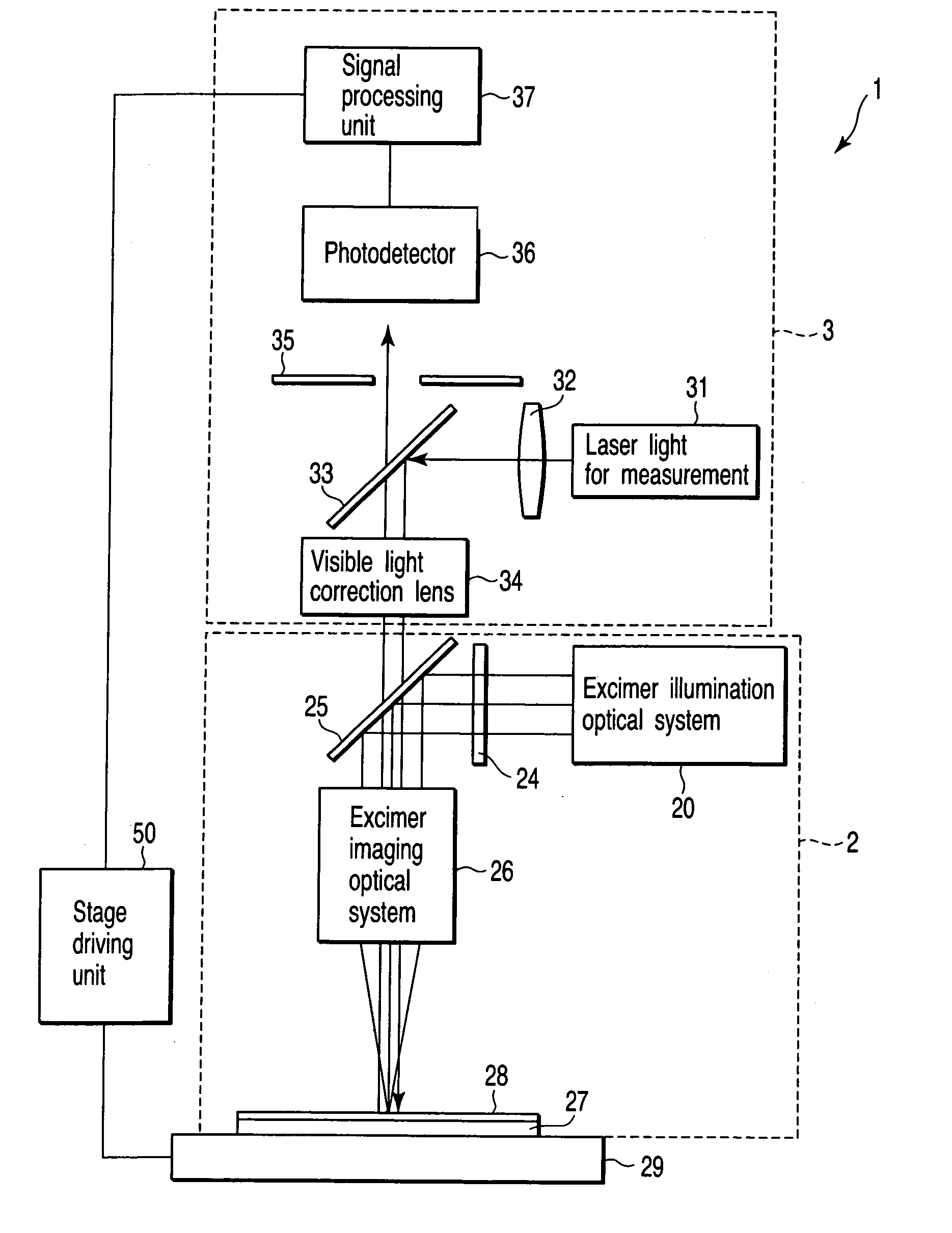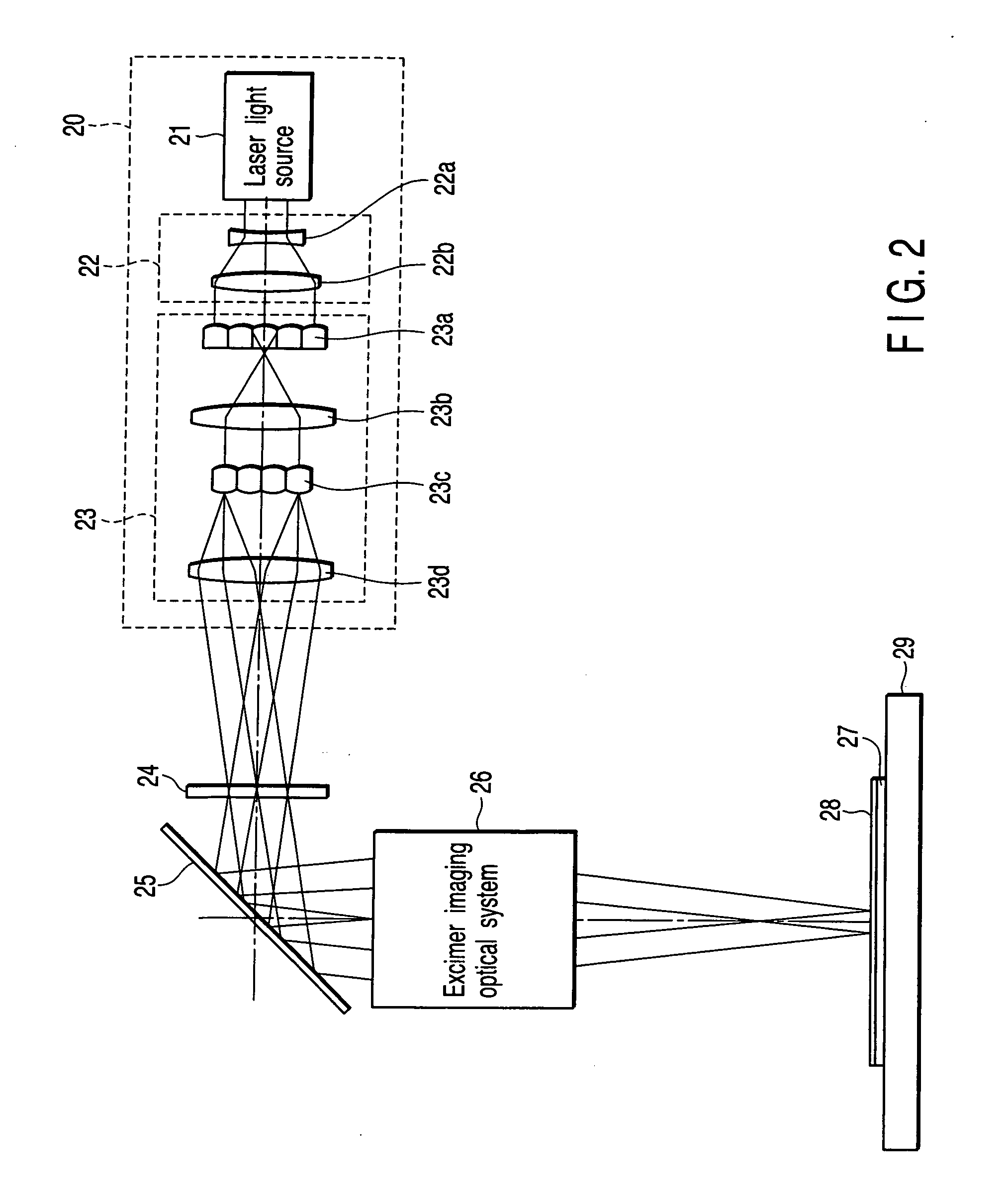Laser crystallization apparatus and laser crystallization method
- Summary
- Abstract
- Description
- Claims
- Application Information
AI Technical Summary
Benefits of technology
Problems solved by technology
Method used
Image
Examples
first embodiment
[0035]FIG. 1 is a schematic diagram of a laser crystallization apparatus 1 according to a first embodiment of the present invention. The apparatus is a laser crystallization apparatus 1 comprising a crystallization optical system 2 projecting an image of a phase modulating element 24 in a reduced size, and a substrate height correction system 3. The apparatus has a function for correcting a shift in a height direction of a substrate 27 to be crystallized based on measurement of the substrate height correction system 3.
[0036] The crystallization optical system 2 comprises an excimer illumination optical system 20 and an excimer imaging optical system 26. The excimer illumination optical system 20 emits and conditions crystallization laser light which illuminates the phase modulating element 24, for example, a phase shifter. The excimer imaging optical system 26 irradiates crystallization laser light whose phase has been modulated by the phase shifter 24 onto a non-single crystal sem...
second embodiment
[0065] A second embodiment relates to a correction system 3 and method in which a specific mask pattern is imaged on a non-single crystal semiconductor film 28 on a substrate 27, a reflected image from the non-single crystal semiconductor film 28 is detected by a two-dimensional photodetector 36A, and then an imaging position is corrected using a two-dimensional image detected.
[0066] One example of the present embodiment is shown in FIG. 4. In FIG. 4, an optical system 2 for crystallization is the same as that in FIG. 1, and therefore a crystallization optical system 2 other than an excimer imaging optical system 26 is omitted. In the present embodiment, visible laser light from a light source 31 for measurement illuminates an image mask 42 having a predetermined pattern for measurement through an illuminating lens 41. The image of the mask pattern for the measurement is reflected on a half mirror 33, directed toward the substrate 27 to be crystallized, and imaged on the non-single...
third embodiment
[0073] A third embodiment relates to one example of a correction system capable of more precisely correcting a substrate position even if a change of lens temperature of an excimer imaging optical system 26 is large. Exactly speaking, a temperature coefficient of refractive index of a lens differs by wavelength of lights, i.e., temperature change in the refractive index of the lens differs for excimer laser light and visible laser light. In the present embodiment, the difference of the temperature change in refractive index of the lens caused by difference of wavelength of the light is further corrected.
[0074] The refractive index of the lens varies with the wavelength of light passed. For example, in calcium fluoride (CaF2), the refractive index for ultraviolet light having a wavelength of 0.2 μm is 1.4951, whereas the refractive index for visible light having a wavelength of 0.5 μm is 1.4365. The difference is about 4%. In fused silica for ultraviolet rays (UV-SiO2), the refracti...
PUM
| Property | Measurement | Unit |
|---|---|---|
| Height | aaaaa | aaaaa |
| Distribution | aaaaa | aaaaa |
Abstract
Description
Claims
Application Information
 Login to View More
Login to View More - R&D
- Intellectual Property
- Life Sciences
- Materials
- Tech Scout
- Unparalleled Data Quality
- Higher Quality Content
- 60% Fewer Hallucinations
Browse by: Latest US Patents, China's latest patents, Technical Efficacy Thesaurus, Application Domain, Technology Topic, Popular Technical Reports.
© 2025 PatSnap. All rights reserved.Legal|Privacy policy|Modern Slavery Act Transparency Statement|Sitemap|About US| Contact US: help@patsnap.com



